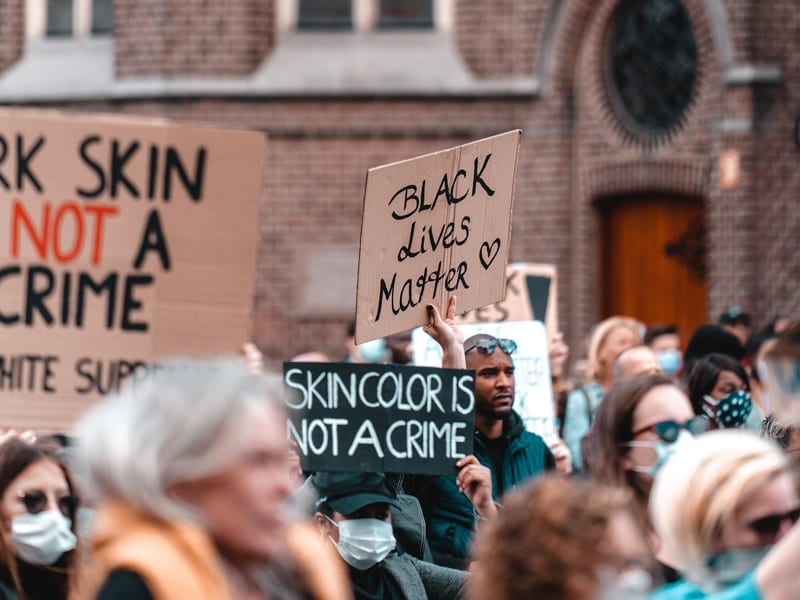A Note from the Editor and Our Sponsor, Laurel House
July is BIPOC Mental Health Month. Recently changed from Minority Mental Health Awareness Month, BIPOC stands for Black, Indigenous, and People of Color. Throughout this month and beyond www.rtor.org will feature content focusing on the racism, inequities, and stigma that make it harder for African Americans, Hispanics, and people of color to access mental health care.
Recent events in our country and the Black Lives Matter movement have focused the attention of us all on the same kinds of issues in our systems of policing, justice, and economic opportunity. Equal access to health and mental health care for African Americans and other people of color needs to be a central part of the public discourse of this moment.
Jay Boll, Editor in Chief www.rtor.org
Linda M. Autore, President and CEO Laurel House, Inc.
When I first began seeing a psychoanalytic therapist, it was for a “severe anxiety disorder,” which was especially triggered by anything that made me feel out of control. Traveling by subway, airplane, car, changed plans, psycho-active substances, big emotions, and, especially, other peoples’ reactions and even their perceptions of me. The unknown was uncomfortable, and the uncomfortable felt unlivable.
Life is full of uncomfortable moments, and to bury our heads in the sand and say “No, thank you” in those moments is not an aid in personal growth, but rather, a momentary out that will only catch up with us in the next uncomfortable moment.
Anti-racism (the policy or practice of opposing racism and promoting racial tolerance) has become a new practice for many White folks, causing a certain level of discomfort among its practitioners. It’s important to spell out and sit with what this means for White people.
White people are now practicing anti-racism. Racism was invented by and has been, whether intended or not, upheld by White people ever since America as we know it began. We are being asked to solve inequalities our ancestors created, and we still benefit from. We are being asked to atone for perpetuating racism, whether or not we intended to perpetuate it. We are being asked to question, analyze, and oppose, in a lot of ways, who we are. And here’s the kicker: there are no gold stars, and this work will continue our entire lives.
Practicing anti-racism is, essentially, the letting go of everything we know about ourselves and the world we live in, bringing it into question, being able to hear and absorb what Black and Brown people in our lives are saying, atoning for how we may have hurt them in the past (even though we “didn’t know then”), and continuing with this practice in light of that. This will be especially challenging for those who fear what is out of their control—out of the known.
I honestly believe that the root of my diagnosed disorder is something that most Americans struggle with in 2020: a paralyzing fear of the unknown. While attending a Zoom call regarding the Black Lives Matter movement, I heard my friend; activist, artist, educator, and host of the podcast The Empathic Realist, Shani Nicole, effortlessly encapsulate why this is:
“People want to stay attached to their identity out of fear.”
I think an important question to ask ourselves is: Why?
Cheryl Harris, who coined the term “whiteness as property,” explains the evolving concept of whiteness and it’s legal history by saying:
“By according whiteness an actual legal status, an aspect of identity was converted into an external object of property, moving whiteness from privileged identity to a vested interest. The law’s construction of whiteness defined and affirmed critical aspects of identity (who is white); of privilege (what benefits accrue to that status); and, of property (what legal entitlements arise from that status). Whiteness at various times signifies and is deployed as identity, status, and property, sometimes singularly, sometimes in tandem.”
When we detach from our identity, we detach from the known. We detach from what has worked for and benefited us our entire lives. We will find many ways to bury our heads in the sand and stay with what’s comfortable, and otherwise imply that it is not our responsibility to fix racism. The only problem with that kind of thinking is that it is our responsibility.
I began seeing a psychoanalytic therapist not long after moving to New York City. Taking the train every day was my personal hell. I would sardine myself into the car and wait, with bated breath, for the doors to close. From the time I got on to the time those doors shut, my mind was on one thing: getting out. “Stand clear of the closing doors, please!” My throat would tighten. The familiar “ding dong” before the doors shut, my vision would blur. Then, the screech of the wheels and the shift of weight would send me into full panic mode.” This is not safe! I cannot get out! I cannot feel like this! Oh God, when will it end?!” We’d pull into the next station. The doors would open, and I would breathe for the first time in two minutes. A lot of times, I would get off the train and let five more go by while I waited for the panic to pass and exhaustion to set in. Then the cycle would repeat until I had reached my destination.
This exhaustive cycle may ring a bell for any given Black person (more specifically, any given Black American) who reads this, though theirs is of an entirely different, much more intense kind. Often referred to as “weathering,” the constant psychological strain of living in a society that operates by oppressing and otherwise demeaning Black communities can lead to a variety of serious health issues in Black people such as hypertension, cardiovascular disease, and even cancer.
In an interview with NPR, White Fragility (free PDF!) author Robin DiAngelo said:
“I heard an interview with Emerald Snipes Garner, who was talking about the death of her beloved sister Erica. She used a metaphor that I think would also be a great description of weathering. She talked about the stresses that she felt led to Erica’s death at age twenty-seven as being like if you’re playing the game Jenga. They pull out one piece at a time, and another piece and another piece, until you sort of collapse. I’m paraphrasing her, but I thought that Jenga metaphor was very apt because you start losing pieces of your health and well-being, but you still try to go on as long as you can. Even if you’re disabled, even if it’s hard, that you have a certain tenacity and hope, and sense of collective responsibility whether that’s for your family or community. But there’s a point where enough pieces have been pulled out of you, that you can no longer withstand, and you collapse.”
Erica Garner, daughter of the late Eric Garner, died of a heart attack at age 27.
Of course, we all go through hard times. We all have those moments when we feel the Jenga pieces being pulled out slowly, one at a time. I had an incredibly hard time riding the train.
My pain can remain valid while co-existing with this truth: I did not have a hard time riding the train because of the color of my skin, or rather, because of racism. It’s not lost on me that a Black woman my age, who also struggles with this fear of the unknown, or riding the train, would likely bear a far greater, more consistent emotional weight than me given the societal oppression she feels on a daily basis, because of the racism we, White people, have invented and perpetuated to oppress people who look like her. To say things like “I don’t see color” or “everyone’s treated the same” is to invalidate the Black experience. The anxiety of not being able to escape the train for those two minutes is something that many Black Americans endure their entire lives. To live in a “color-blind” society is to live in a blind one that further oppresses its Black citizens.
If you happen to be White and your throat is tight, your palms are sweating, or you are feeling any sort of discomfort, congratulations: Welcome to the beginning of growth. Resman Menakem says in his book My Grandmother’s Hands: Racialized Trauma and the Pathway to Mending Our Hearts and Bodies:
“The traumas that live in white bodies, and the bodies of safety professionals of all races, are also deep and persistent. However, their origins and nature are quite different [than those of Black bodies]. The expression of these traumas is often an immediate, seemingly out-of-the-blue fight, flee or freeze response, a response that may be reflexively triggered by the mere presence of a Black body—or, sometimes, by the mere mention of race or the term white supremacy or white-body supremacy.”
It is high time for White America to get uncomfortable so that Black America can finally rest. Sujan Patel, a former contributor at Forbes, said in his piece, Why Feeling Uncomfortable is the Key to Success:
“That’s why being uncomfortable is something you should embrace. Putting yourself in new and unfamiliar situations triggers a unique part of the brain that releases dopamine, nature’s make-you-happy chemical. Here’s the mind-blower; that unique region of the brain is only activated when you see or experience completely new things.
Few people actually enjoy the feeling of being uncomfortable. The challenge is to get past that initial feeling of wanting to return to the norm, so you can grow and benefit from that discomfort.”
So, how does one start acquainting oneself with the uncomfortable?
- Acknowledge & accept the need for growth. This can feel like a lot of things: confusion, sadness, anger, rage, hopelessness, anxiety, and shame. How to know if there is room to grow? Trick question – there always is. We can acknowledge this by asking ourselves uncomfortable questions, such as: Why does this make me uncomfortable? Do I hide from or put off uncomfortable conversations? Are there conversations that I wish I could have, but just seem impossible? Have I perpetuated racism in the past? If so, what does that mean for how I’ll live my life going forward? Be aware of how these questions make you feel. Angry? Defensive? Sad? Hot? Itchy? Sweaty? Question why those feelings and reactions are coming up, and give yourself space to breathe into, challenge, and feel them. The Great Unlearn by Rachel Cargle and White Fragility by Robin DiAngelo are a couple of many great places to start for those doing anti-racism work.
- Find your safe space. This can mean finding a therapist, friend,* family member, caucus or affinity group, or even your journal. In this safe space, bring your acceptance of the need for growth and ask more of the questions that make you uncomfortable.
*Please note that while doing one’s anti-racism work, especially in the beginning, it is not appropriate (or necessary) for White folks to ask their Black and Brown friends for advice on how to fix their inherent racism. They did not create the problem, and though many brilliant Black minds have laid the groundwork and created incredible resources for this work, it is not their responsibility to solve it. Speaking of brilliant Black minds and their resources…
- Educate yourself… slowly & consistently. Ever hear the expression “knowledge is power?” Uneasy feelings can often be quelled simply by naming them. Learn about whatever is making you uncomfortable. I will emphasize again how important it is to take this work slowly. Often when we take in a lot of new information at once, it is easy to become distracted by thoughts of our past experiences that mirror what we are reading, fantasies of how we might put what we are reading into action, or to otherwise check out or glaze over. This is why many people bring someone with them to serious doctor’s appointments to take notes; the new information can be so intense that our consciousness drifts and goes into protection mode. It’s fine if this happens, just give yourself a moment to reflect and reframe, and then re-read the passage again. If reading is not your preferred learning method, there are many incredible documentaries, films & podcasts as well.
- Actively practice getting uncomfortable. For me, all those years ago, it meant not lying to myself anymore. “I’m fine. There’s no problem. It’ll be better tomorrow.” It was never better tomorrow. My crippling anxiety never disappeared. I just began truly addressing it. I changed my narrative to “This is hard for me. But I can do it, and I’m okay.” Now, when I feel a panic attack coming on or enter an uncomfortable conversation, I breathe into it, not out of it. We need to breathe into the life of uncomfortable work. That means owning up to the ways we have avoided growth, and the effect it has had on our lives and those of others. When specifically talking about anti-racism, another way we can actively practice anti-racism is by being consistent. One can’t be anti-racist in front of their Black friends and not in front of their White, conservative friends—that’s not how this works. As the author of the book On Being Human, Jennifer Pastiloff, often says:
“May I be who I say I am.”
I find so much power in that expression. Studies have shown that standing up for oneself can lead to increased self-esteem. Lorna Collier for the American Psychological Association lists helpful tips for how to stand up for yourself; I especially appreciate her tips to “Practice, practice, practice,” “Consider your audience,” and “Pretend the roles are reversed,” when approaching any conversation regarding racism.
- Put your heart where your mouth is. That is to say, anti-racism, and building a tolerance for uncomfortable moments, is a life-long lifestyle change. As long as racism exists, it will be our job not only to stop perpetuating it but actively work to eradicate it. This may look like: making more of your purchases from Black-owned businesses; voting and regularly calling for anti-racist, legislative change; hiring Black employees within your company; speaking up when and if you witness racism in the workplace (yes, even though you could lose your job); and, most importantly, changing the way you walk in this world. If you see injustice, stand up. If you hear of injustice, speak out. If you feel yourself getting uncomfortable around someone, ask yourself why and breathe into it. If helping change the world for the better isn’t enough incentive, you’ll certainly feel more confident once you are able to see the uncomfortable for what it is: just that, uncomfortable. Not unlivable, but rather, doable.
About the Author: Kayleigh Shuler is a writer from New York. Aside from writing about mental health and personal development, she enjoys writing scenes and monologues for actors, screenplays, and poetry. Kayleigh enjoys reading, spending time in nature and being with her sweet cat, Phoebe. @kayleigh_shuler on Instagram. kayleighshuler.com
Photo by Joan Villalon
The author and www.rtor.org have no affiliations with any products or services mentioned in the article or linked to therein. Guest Authors may have affiliations to products mentioned or linked to in their author bios only.
Recommended for You
- Veterans and Addiction Recovery: How Families Can Support Their Service Member’s Healing Journey - July 14, 2025
- Trauma-Aware Yoga: A Gentle Path to Healing and Recovery - July 10, 2025
- Why Eating Disorders in Men Are Often Missed - July 3, 2025






FYI –the quote attributed to Robin DiAngelo should instead be attributed to Dr. Arline T Geronimus, who originated the concept of Weathering and made that statement in an NPR interview with Kai Wright.
Correction to my earlier comment. I made the Jenga comparison to weathering in an NPR interview with Gene Demby. See: https://www.capradio.org/news/npr/story?storyid=577664626
Dr. Arline T. Geronimus,
Thank you so much for reading and commenting on this blog.